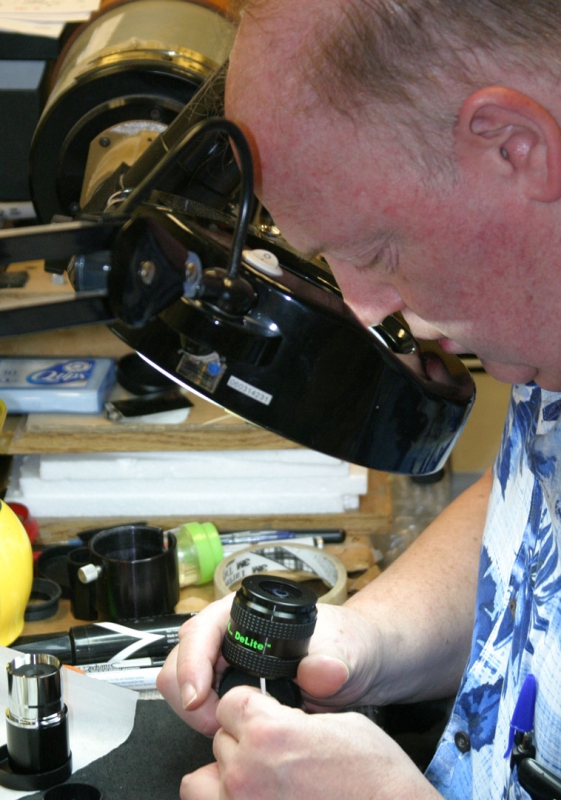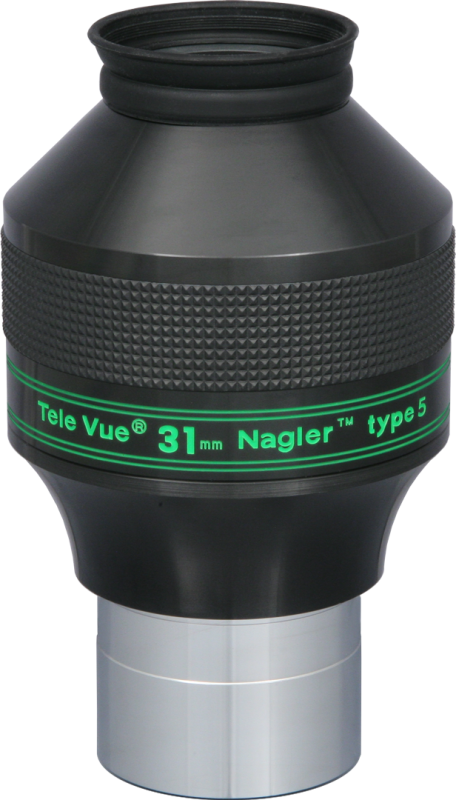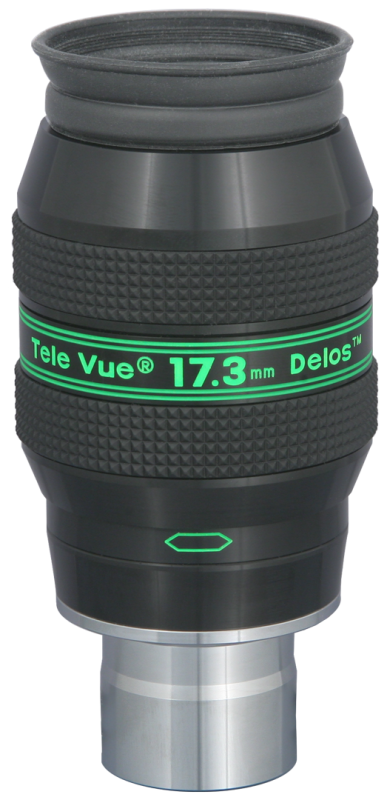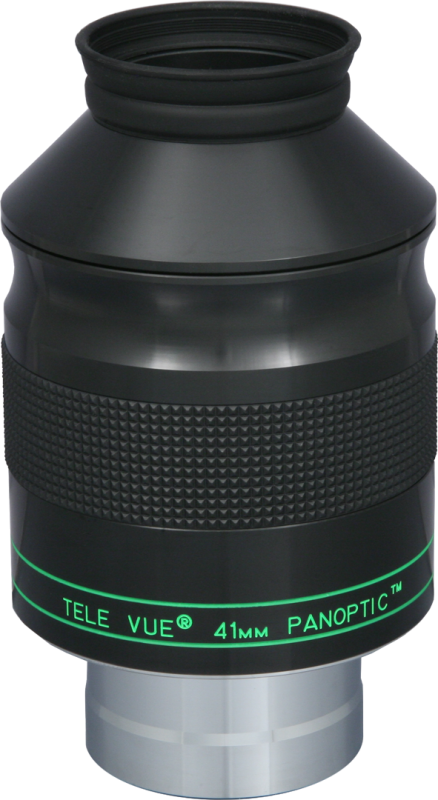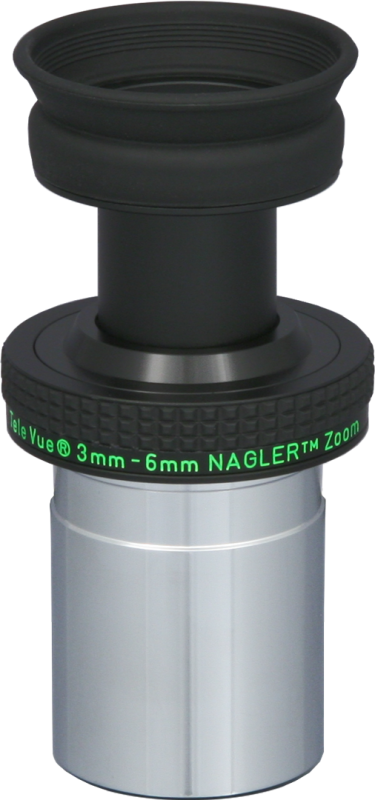Sketching the Universe!
When sketching at the eyepiece, one has to be cognizant of the relative distances between the stars, their brightness, and asterisms they form. For example, in Martijn Straub’s Omega Centauri sketch description, there is mention of the “oval” structure with dark “pockets” and stars in a “trapezoid shape.” Thus the beauty of sketching at the eyepiece is that it leads to a more intimate knowledge of the object and the star field around and within it.
Fish Head Nebula
For this next image, Richard Orr made great use of a PVS-14 Night Vision monocular on an a 67mm eyepiece (modified Tele Vue 55mm Plössl) with Hydrogen-Alpha filter. Observing through a modest 110mm aperture refractor, Richard created a detailed sketch of the Fish Head Nebula and surrounding objects that normally would have required a big Dobsonian to reveal. Along with the The Fish Head (NGC 896), the sketch includes the Heart Nebula (IC 1805), an Emission Nebula (IC 1795) and an Open Cluster (Mel 15) embedded in the Heart Nebula.
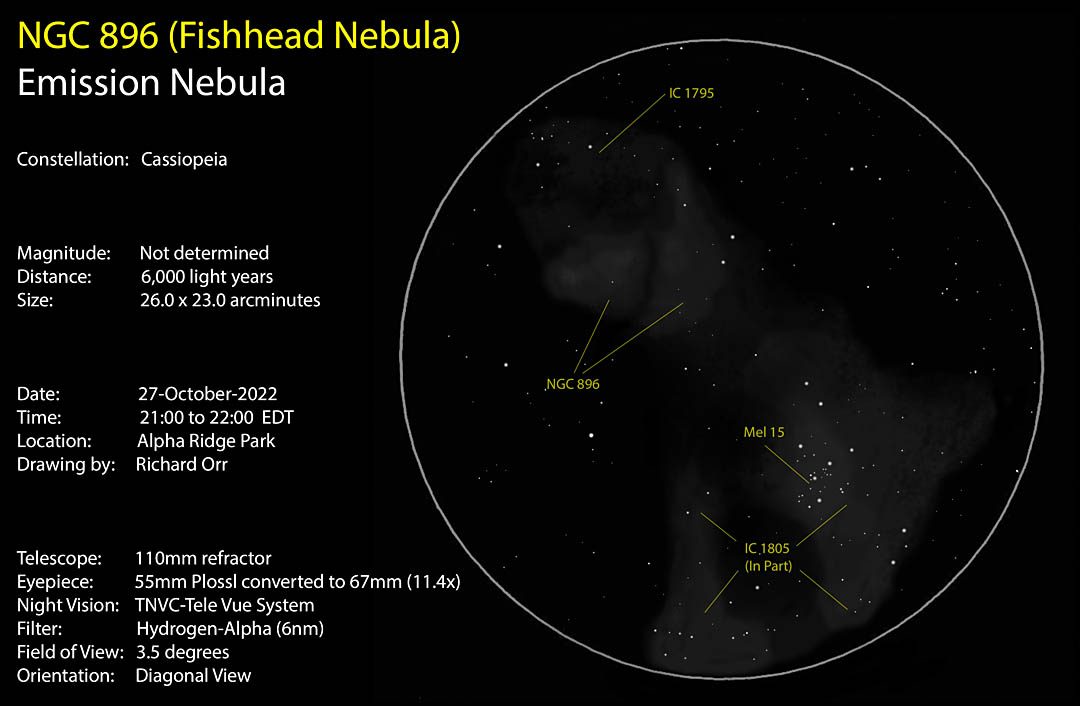
The Fish Head is actually a bright knot in the western part of the Heart Nebula: part of a complex of star forming regions along the edge of a large molecular cloud over 6,000 light-years away, The “fish head” shape arises from a combination of thick obscuring clouds and ionized, glowing gas – mostly hydrogen – energized by young stars forming within the cloud. A PVS-14 night vision monocular attached to Tele Vue’s 55mm Plössl with 67mm converter gives you the maximum possible true field a telescope with 2″ eyepiece holder can produce. This allowed Richard a 3.5° field of view for this sketch.
Omega Centauri
Martijn observed Omega Centauri (NGC 5139) from Namibia and noted the following:
It’s incredibly large and bright, but not really denser towards the core; the condensation is most evenly spread throughout the whole globe, only fractionally brighter in the middle. The shape is definitely oval and defined quite well near the edges. In the center I noticed two darker pockets, like eyes, with in between them a thin line of tiny stars. Up and right within the cluster a small star chain could be seen, like a short arm. A similar line was seen down and left, but outside of the cluster. On the left side of the core, a few stars in a trapezoid shape shone just a tad brighter.
The scope used was a 16″ f/4.5 Newtonian with Tele Vue 31mm Nagler Type-5 eyepiece (58x) in order to “sketch this one at the lowest magnification, to seemingly shrink the cluster to somewhat acceptable proportions”.
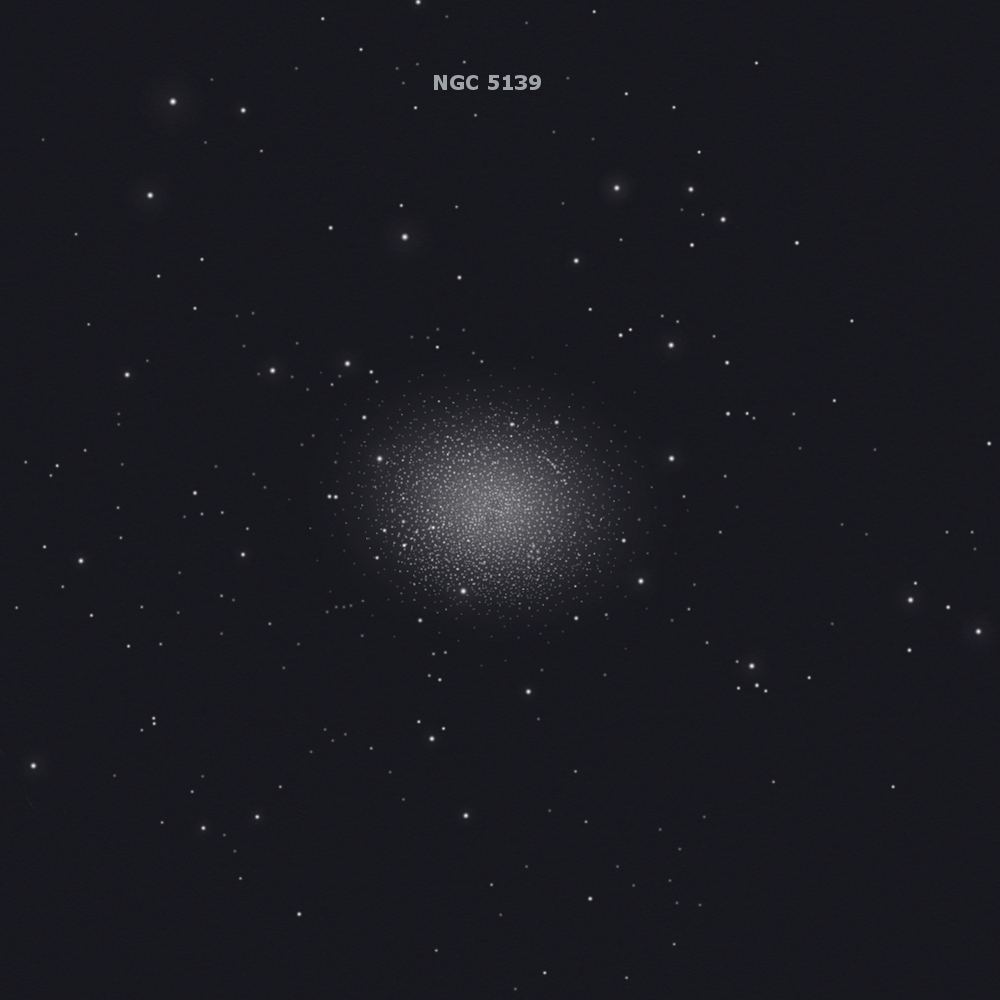
The Omega Centauri (also NGC 5139, or Caldwell 80) globular cluster is the most massive in our Milky Way galaxy with 10-million stars. At only 16,000 light-years distant, it is one of the closest known globulars. These facts make this one of the most visually striking targets in the night sky. In order to keep the size of the globular small in the field of view of a telescope with over 1,800mm focal length, the wide field afforded by the Nagler 31mm Type-5 was put to good use. It’s 19mm of eye-relief must have made it a comfortable eyepiece to use for the sketching process.
Tarantula Nebula
David Daelman traveled to the southern hemisphere to collect this denizen of the southern skies: the Tarantula Nebula (NGC 2070). Through a 12″ f/4.8 Newtonian and Delos 8mm (180x) eyepiece the sketch was made with the assistance of an OIII filter. For this effort, he was the June 2022 CloudyNights Sketch Contest Winner!
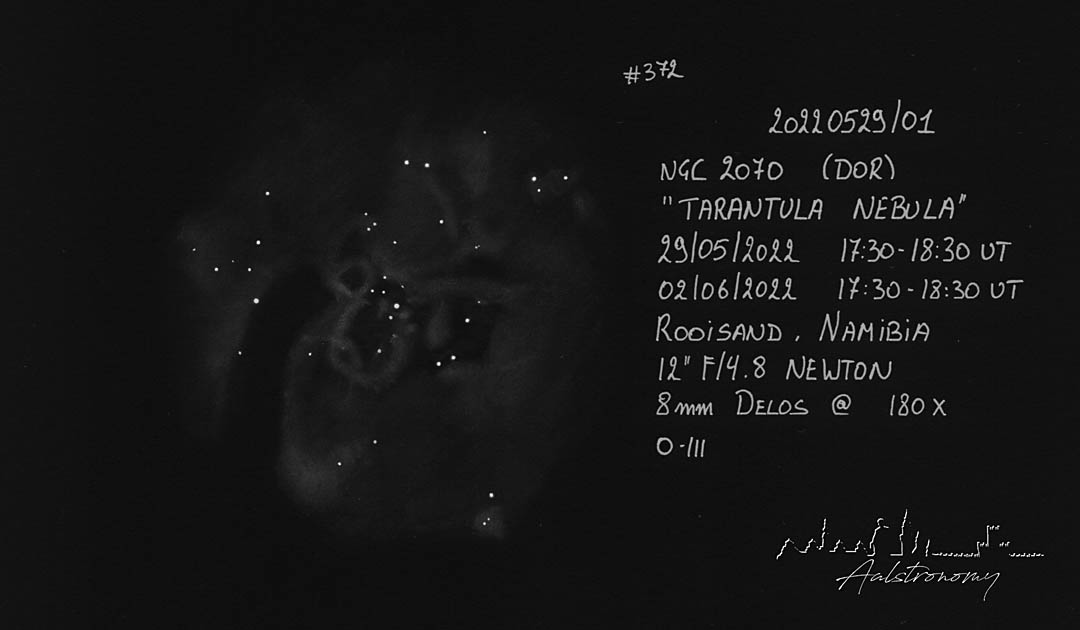
Located in the neighboring Large Magellanic Cloud ― a satellite galaxy of our Milky Way ― the Tarantula Nebula (also cataloged as 30 Doradus) ─ is a large cloud of hydrogen gas and dust where star formation continues to take place. In fact, the rate of star formation is the highest of any region in our Local Group of galaxies. We can see it because the new stars in the Tarantula emit ultra-violet photons that energizes the surrounding hydrogen to glow. In order to sketch the “heart” of the nebula at high power without loss of field, a Delos 8mm eyepiece was used in the 1,460mm focal length scope to view the target at 180x with a 0.4° field of view.
Saturn and Moons
On first glance, we truly thought this image by Richard Orr was a photograph! It turned out to be a sketch through a 155mm refractor, 1.7x Barlow and several Delos eyepieces and colored filters.
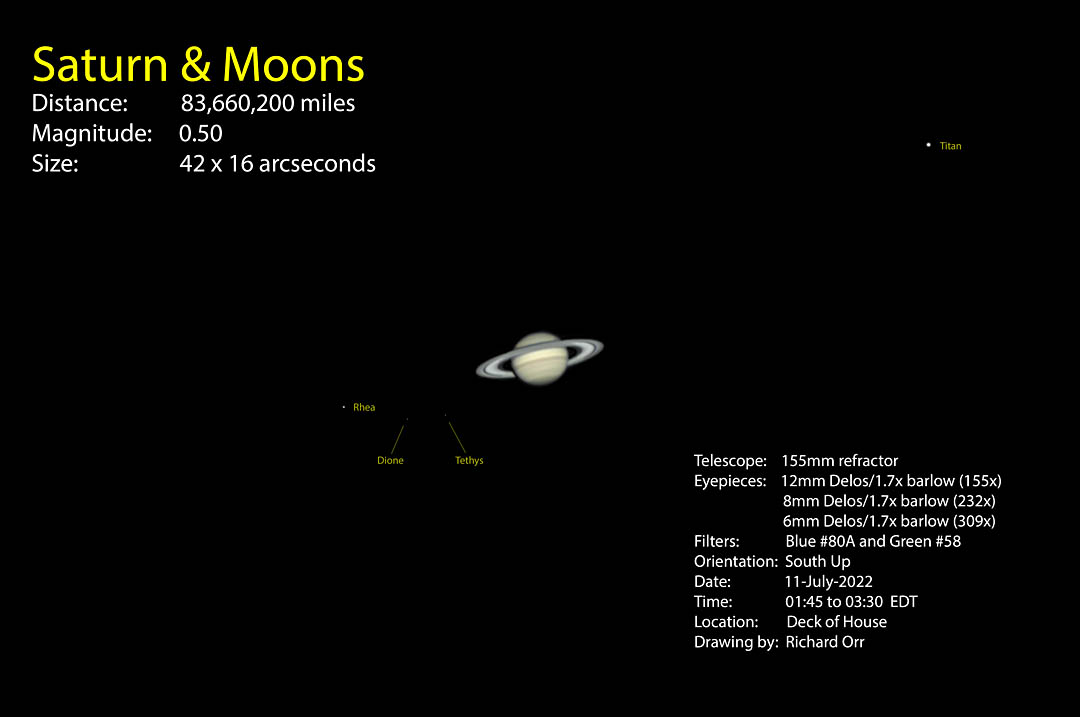
The 20mm eye-relief afforded by the Delos line makes viewing comfortable at the high, planetary powers used for this sketch. The 72° apparent field of the Delos, even at the approximately 1,850mm focal length of the observing setup, provided an almost ¼° field of view at the 309x observation with the Delos 6mm.
NGC 5286 (Globular Cluster)
David tells us that this cluster in the southern constellation Centaurus is “large, bright, rich and accompanied by a very bright orange star, M Centauri. Two little star chains are seen on the disk, the globular itself remains unresolved.”
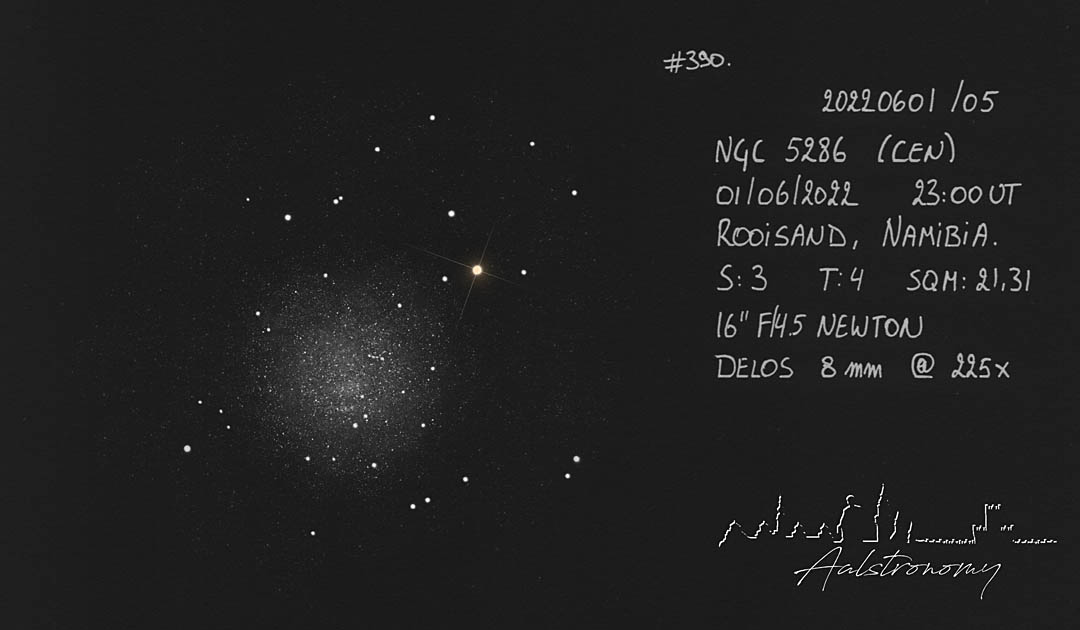
This cluster is easy to locate as the star M Centauri (magnitude 4.6) is only 4-arc-minutes away. David tells us that his “standard eyepiece set is the entire Delos series, and the Paracorr Type 2.”
Orion Nebula
“Staggering wispy details throughout entire field of view!” is how Tom Corstjens describes the sketch of the Orion Nebula below.
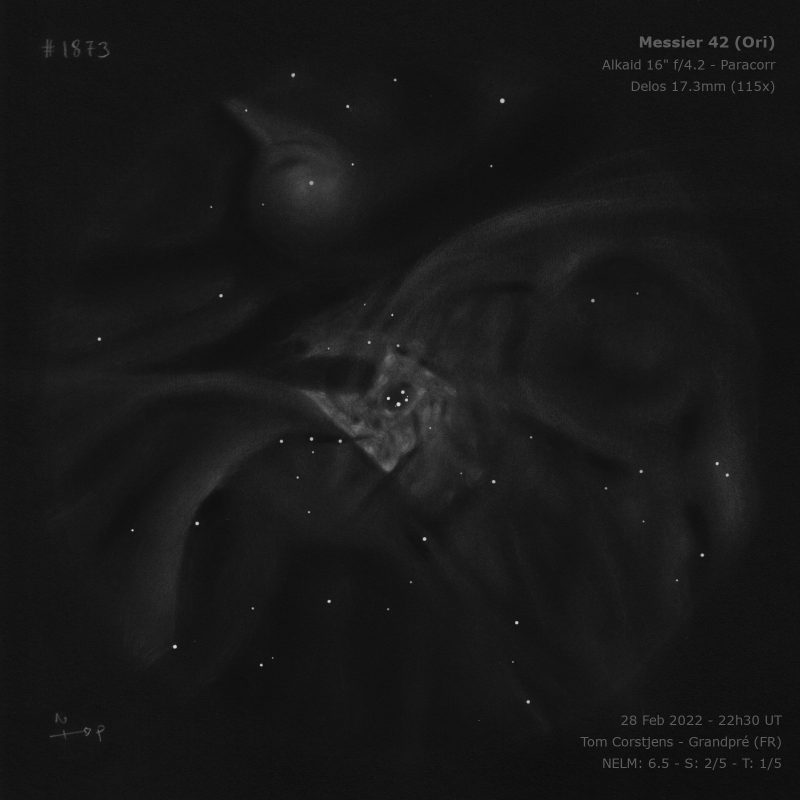
The Orion Nebula (also M42 or NGC 1976) is the most easily visible and closest region of massive star formation to our planet. Scientists believe there are 700 stars at various stages of evolution within the nebulosity. This means there are plenty of hot, giant, young stars to pump-up the electrons in the cloud of hydrogen gas in the nebula and cause them to emit light. The richly detailed wisps and folds in the sketch are shaped by shock waves from strong stellar winds from these young stars. The four stars at the heart of the nebula in the sketch are the most visible stars of the Trapezium cluster. The nebulosity at the top of the image is known as M43. It is physically part of M42 but appears separate because of a dark lane of dust slashing through the this glowing star forming region. This sprawling object is over a degree across. The 17.3mm Delos eyepiece used in the drawing gave a field of view of over 0.6° at the medium-high power required to tease out the details in the object. This was possible while still allowing for 20mm of eye-relief.
Comet Leonard Passing M3 (Globular Cluster)
Messier 3, a globular cluster in Canes Venatici, is of note for being the first Messier object discovered by the catalog compiler Charles Messier. Considered one of the finest globulars in the northern hemisphere after M13, Comet Leonard passed within arc-minutes of this object on December 3, 2021. Eric Klaszus memorialized this event in the following sketch. For the effort, this image was a December 2021 CloudyNights Sketch Contest Winner!
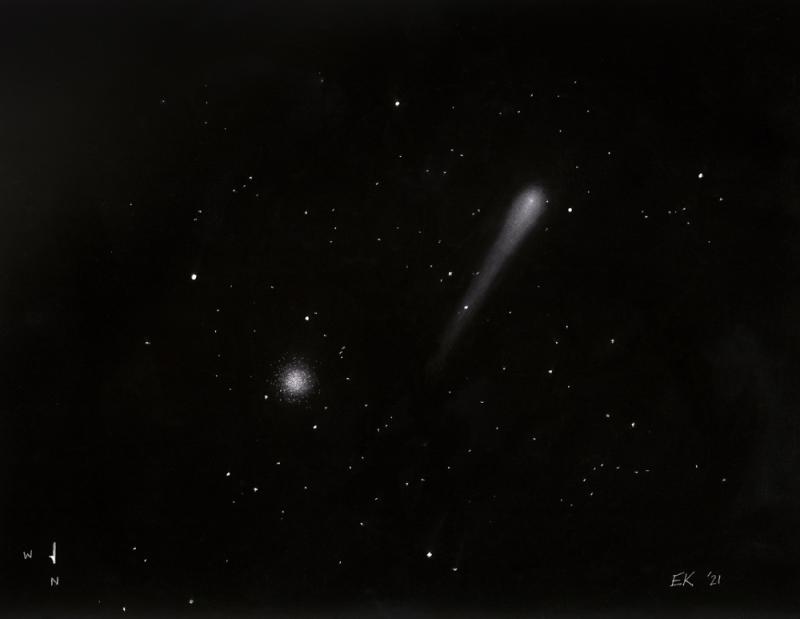
On this scope, the Panoptic 35mm provided 73x with an almost 0.9° true field and 6mm exit pupil while providing 24mm of eye-relief.
Eta Carinae Nebula
Martijn Straub observed and sketched the famous Eta Carinae Nebula from Namibia and it left quite an impression. We quote from his DeepSkySketch.com blog below.
It’s hard to describe what it does to a person, viewing this nebula complex for the first time. Imagine that you (as a northerner) have studied over a thousand objects for many years. And that only then you view the Orion Nebula for the first time… . That’s about how if felt when I observed this area on the first night through the 16″, it was a whole new experience. The HII area is extremely large and does not fit in the field of view, not even with the Nagler 31mm applied. The heart of the area lies with the star to which the complex owes its name. It’s more or less at the top of the brightest part that sticks to the bottom left, like a knife. Just left of this star a remarkable dark zone can be seen as an “8”; the famous Keyhole Nebula. The edge of this brightest part is so strongly defined, that the dark area beside it looks like a black canyon. Only at the top of this, where the dark lane makes an almost 90 degree bend, some patches of nebulosity are noted. On the opposite of the dark zone an area of nebulosity is observed that stretches beyond the field of view. It’s impossible to draw it perfectly accurate, but I tried to pay attention to the differences in brightness and spots where it is darker. On the first evening of the sketch I only drew the (many) stars. This took a long time because I wanted to be very accurate. On the second evening I continued with the nebula, now thankful for a paper full of stars that I could use as anchor points. When I finished the sketch I had a close up look at Eta Car (the star). It’s in the final phase of its life cycle and therefore a planetary to-be, the so called “Homunculus Nebula“. The two extensions can be seen, different in size and shape. Nice!
This is a phenomenal piece of heaven around Eta Carinae. It left a deep impression on me that I won’t forget easily… This is definitely in my top-5 of most beautiful objects, perhaps even as the #1.

Also known as the Great Carinae Nebula (NGC 3372) it is located in the southern sky constellation of Carina (ship’s keel). The shape of the nebula is sculpted by shockwaves and radiation pressure from many supernova explosions while radiation has ionized regions in the nebula and caused them to glow. Dark shapes entwined in the nebula are remnants of clouds of cool gas and dust from which the first giant stars in the nebula were born. The most energetic star in the complex, double-star Eta Carinae, is thought to be on the verge of a supernova explosion.
Did you observe, sketch, or image with Tele Vue gear? We’ll like your social media post on that if you tag it #televue and the gear used. Example:
#televue #tv85 #ethos #jupiter
Do you want your Tele Vue images re-posted on Tele Vue Optics’ Social Media accounts? Use this hashtag for consideration:
#RPTVO
More Info
- Astro Sketching the Universe! guest blog post with sketching advice.
- Blog post The Art of Deepsky Sketching at the Eyepiece has more of Tom Corstjens’ work.
- Moon sketching blog post: Return to the Moon with Michel Deconinck
- More Moon sketching: The Art of Sketching the Moon at the Eyepiece
- More advice from Tele Vue on choosing eyepieces (mobile version) including for specific model scopes.




